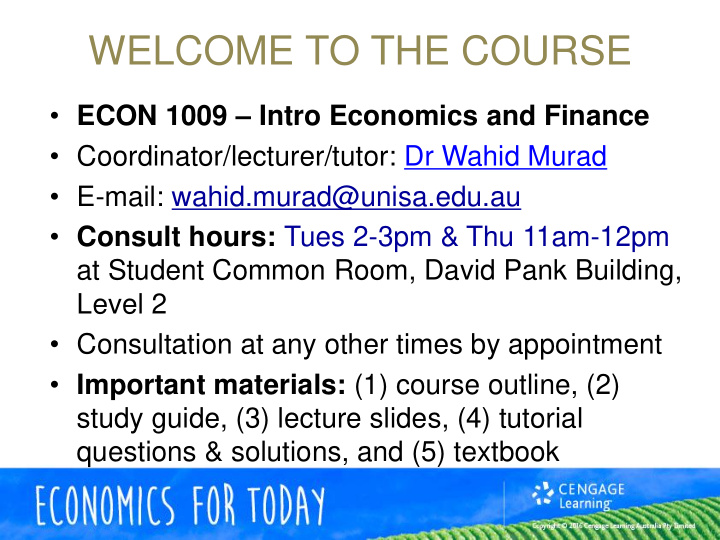



WELCOME TO THE COURSE • ECON 1009 – Intro Economics and Finance • Coordinator/lecturer/tutor: Dr Wahid Murad • E-mail: wahid.murad@unisa.edu.au • Consult hours: Tues 2-3pm & Thu 11am-12pm at Student Common Room, David Pank Building, Level 2 • Consultation at any other times by appointment • Important materials: (1) course outline, (2) study guide, (3) lecture slides, (4) tutorial questions & solutions, and (5) textbook
TOPIC 1 Thinking like an economist Presenter: Dr Wahid Murad
KEY POINTS • The problem of scarcity • Scarce resources and production • Economics: the study of scarcity and choice • The branches of economics • The methodology of economics • Hazards of the economic way of thinking • Why do economists disagree? • Positive and normative economic statements
THE PROBLEM OF SCARCITY • The condition in which human wants are forever greater than the available supply of time, goods, services and resources. • Examples: – individuals: bigger flat-screen TV, more restaurant meals, more leisure time – governments: highways and defence.
SCARCE RESOURCES AND PRODUCTION • Because of the economic problem of scarcity, no society has enough resources to produce all the goods and services necessary to satisfy all human wants. • Economists divide resources into three main categories: land, labour and capital.
THREE CATEGORIES OF RESOURCES
RESOURCES: LAND • Any resource provided by nature. • Includes anything natural above or below the ground. Examples: forests, minerals, oil, wildlife, rivers, lakes and oceans. • May be renewable or non-renewable.
RESOURCES: LABOUR • The mental and physical human capacity of workers to produce goods and services. • Examples: services of farmers, nurses, doctors, factory workers, lawyers, professional football players, teachers and economists.
ENTREPRENEURSHIP • Entrepreneurship is the creative ability of individuals to seek profits by combining resources to produce new or existing products – Examples: • Bill Gates, Jeff Bezos, Elon Musk, Joseph Nathan, Mark Zuckerberg, and many others like them
RESOURCES: CAPITAL • The physical plant, machinery and equipment used to produce other goods. • They are human-made goods that do not directly satisfy human wants. • In economics, money is not capital. It simply gives a measure of the value of assets, including capital goods. Money is used simply to purchase goods and services for consumption.
ECONOMICS: THE STUDY OF SCARCITY AND CHOICE • The problem of scarcity forces people to make choices. It is the basis for the definition of economics. • Economics is the study of how society chooses to allocate its scarce resources to the production of goods and services in order to satisfy unlimited wants.
ECONOMICS • Society makes two kinds of choices: – economy-wide (Macro) – individual (Micro) • Economics consists of two main branches: – Microeconomics – Macroeconomics
TWO BRANCHES OF ECONOMICS • studies decision-making by a single individual, Microeconomics household, firm or industry • studies the performance of, and decision-making in, Macroeconomics the economy as a whole
THE METHODOLOGY OF ECONOMICS • Economists (like scientists) use the same scientific method for solving economic problems. • The scientific method is a step-by-step procedure for solving problems.
THE STEPS IN THE ECONOMIC MODEL-BUILDING PROCESS
EXAMPLE: PETROL CONSUMPTION Identifying the problem • Petrol consumption by motorists has fallen. Why? Developing a model • Identify the variables − petrol price, car prices. • Express them verbally, graphically or mathematically. Testing the model • Gather data that tells us how well the model estimates or predicts relationships.
HAZARDS OF THE ECONOMIC WAY OF THINKING • There are two potential problems to be aware of: 1. the ceteris paribus assumption 2. possible confusion of association and causation
CETERIS PARIBUS • Latin phrase: means that while certain variables change, ‘all other things remain unchanged’ . • The assumption holds everything else constant and therefore allows us to concentrate on the study of the relationship between two key variables.
ASSOCIATION VERSUS CAUSATION • We cannot always assume that when one event follows another, the first caused the second. • For example, assume Australia’s imports from Indonesia rose last month. Two events might be associated: 1) the coronavirus related deaths worldwide grew last month. 2) currency movements reduced the cost to Australians of buying Indonesian goods. • But are they both possible causes?
POSITIVE ECONOMIC STATEMENT • Deals with facts and therefore addresses ‘what is’ or ‘ verifiable ’ questions. • The key consideration for a positive statement is whether the statement is testable or not and whether it is true or false. • Examples: – ‘Airbags save lives.’ – ‘Smoking is harmful to your health.’ – ‘Today’s temperature is 30 0 c.’
NORMATIVE ECONOMIC STATEMENT • Normative economics is an analysis based on value judgments. • It cannot be proven by facts to be true or false. • Examples: – ‘Every teenager who wants a job should have one’. – ‘ Keeping inflation under control is more important than teenage unemployment ’ .
Recommend
More recommend